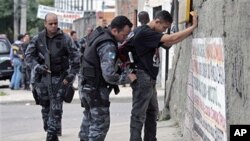The United States is pursuing a broad range of counter narcotics programs that seek to foster citizen safety and impede the ability of transnational criminal groups to operate in the Western Hemisphere.
"We are facing complex and evolving threats from a wide range of transnational criminal organizations, drug traffickers, foreign terrorist groups, and violent youth gangs in the region," said Assistant Secretary for the Bureau of International Narcotics and Law Enforcement Affairs, William Brownfield. "Illegal narcotics remain the financial lifeblood of these organizations."
In South America, proceeds from illegal drugs are frequently used by extremist groups to attack their governments through acts of violence, kidnapping and extortion. Criminal gangs in Mexico have not revealed strong political aspirations and are willing to use shocking amounts of violence unseen since the days of Pablo Escobar to protect their criminal interests.
But as these criminal organizations are increasingly under attack in Mexico and South America, they have expanded their operations in Central America, where weak institutions, remote, often unpatrolled national border regions, and a failure by nations to invest in citizen safety programs and to address the root causes of crime, allow free reign to traffickers and organized crime.
The United States learned a lot from a decade of supporting Colombia’s efforts fighting drug cartels. In time, Colombia not only developed stronger institutions more capable of combating narcotics cultivation and trafficking, but it also instituted critical reforms to promote social and economic development.
"We have learned from Plan Colombia and the Merida Initiative that ... only by helping to protect the people of Central America can we hope to build the partnerships necessary to fight transnational crime," said Assistant Secretary Brownfield. "We have also learned that progress in one region without building institutions in the next will only move the threat.”
"That is why we have launched both the Central America Regional Security Initiative and the Caribbean Basin Security Initiative, two regional partnerships aimed at improving these nations’ ability to cooperate with each other as well as with the United States.
"Crime and violence anywhere in this hemisphere," he said, "threatens the United States as well as its neighbors, and we must work together to ensure the security and well being of all Americans."
Western Hemisphere Drug Strategy

The United States is pursuing a broad range of counter narcotics programs that seek to foster citizen safety and impede the ability of transnational criminal groups to operate in the Western Hemisphere.






















